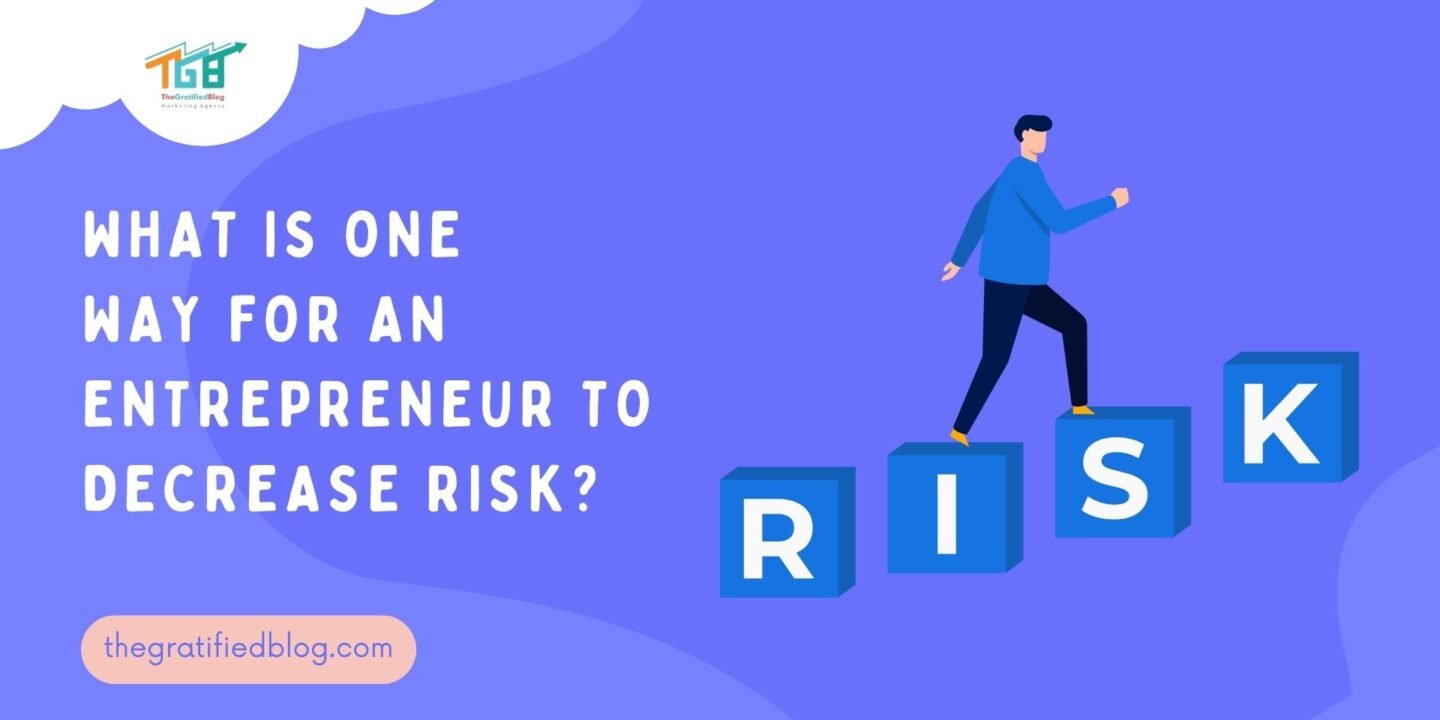
Stepping into entrepreneurship is both exciting and empowering, but it also comes with risks. Entrepreneurs face uncertainty in everything from finances to market demand, making it essential to find ways to minimize potential setbacks. While risk is a natural part of running a business, smart strategies can help reduce it and increase the chances of long-term success.
So, what is one way for an entrepreneur to decrease risk? Let’s explore this question and uncover practical solutions that can make a real difference.
Understanding Risk In Entrepreneurship
Risk is a big part of starting and running a business. Entrepreneurs take risks when they:
- Invest money in a new idea
- Hire employees
- Launch a new product or service
- Enter a competitive market
Some risks are small, while others can cause a business to fail. The key to success is knowing which risks to take and how to manage them.
Every business decision comes with some level of uncertainty. But with proper planning, research, and smart decision-making, an entrepreneur can lower risks and increase the chances of success.
Why Risk Management Matters?
Risk management means finding ways to avoid, reduce, or handle risks before they become big problems. It is an important part of running a business because it:
- Helps avoid financial losses
- Keeps the business stable and secure
- Builds confidence in investors and customers
- Improves decision-making
Many businesses fail because they do not prepare for risks. A smart entrepreneur identifies possible risks early and takes steps to reduce them.
Key Risks Entrepreneurs Face
Starting a business comes with many challenges. Entrepreneurs should be aware of the main risks that could hurt their business.
1. Financial Risk
Most businesses need money to start and grow. If expenses are too high or sales are too low, the business can fail.
2. Market Risk
A product or service may not be as popular as expected. If customers do not want or need it, the business will struggle.
3. Competition Risk
Competitors may already be offering similar products. If a business does not stand out, customers will choose other options.
4. Legal Risk
Not following business laws can lead to big fines. Entrepreneurs must ensure they have the right licenses and follow regulations.
5. Operational Risk
Things can go wrong inside the business. This includes supply chain problems, employee mistakes, or unexpected disruptions.
6. Technology Risk
Businesses rely on technology. A website crash, cyber-attack, or outdated software can create major problems.
7. Reputation Risk
A bad customer experience can damage the business reputation. Negative reviews and social media complaints can hurt sales.
By understanding these risks, entrepreneurs can prepare and take action to reduce them.
What Is One Way For An Entrepreneur To Decrease Risk?
One of the best ways for an entrepreneur to decrease risk is market research. Understanding the market before launching a business can save time, money, and effort. Let us understand what market research is and see why it is a powerful tool for reducing risk.
What Is Market Research?
Market research is the process of gathering and analyzing information to understand market conditions, customer preferences, and industry trends. It helps an entrepreneur determine:
- What customers want – Understanding their needs and preferences.
- What products or services are already available – Identifying market gaps and competition.
- How much people are willing to pay – Setting competitive and profitable pricing.
- Who the competitors are – Learning from their strengths and weaknesses.
- What trends are shaping the industry – Adapting to changes and staying ahead.
With this information, entrepreneurs can make smarter business decisions, create effective marketing strategies, and avoid costly mistakes that may lead to business failure. Market research is essential for long-term success and growth.
Why Is Market Research Important?
If you open a restaurant in a neighborhood where people prefer fast food over fine dining, your business may struggle. If you launch a product that nobody needs, it will not sell. Market research helps avoid these problems.
Here is why market research is useful:
- Prevents wasting money – Helps in making the right investment choices.
- Identifies demand – Ensures there is a need for the product or service.
- Finds competitors – Helps an entrepreneur learn from others.
- Improves pricing strategy – Finds out how much people are willing to pay.
- Enhances marketing – Helps in creating the right message for customers.
Market research removes guesswork. Instead of making random decisions, an entrepreneur uses real facts to shape the business.
How To Do Market Research?
Market research does not have to be complicated. Even simple steps can provide valuable insights. Here are some ways to get started:
1. Talk to People
One of the easiest ways to research the market is by talking to potential customers. Ask them questions like:
- What problems do you face in this industry?
- What solutions do you use right now?
- What do you like or dislike about existing products or services?
People love sharing their opinions. Their answers can help shape a better product or service.
2. Survey Customers
Surveys allow entrepreneurs to collect information from a larger audience. Online tools like Google Forms or Typeform make it easy to create and distribute surveys.
A good survey should include:
- Simple and clear questions
- Multiple-choice options for easy answering
- A mix of open-ended and closed-ended questions
3. Observe Competitors
Competitors can teach a lot. Look at their:
- Products and pricing
- Marketing strategies
- Customer reviews
- Strengths and weaknesses
Reading customer reviews of competitors’ products can reveal what people love or dislike. This helps an entrepreneur create a better offering.
4. Test the Idea on a Small Scale
Instead of launching a full business immediately, start with a small test. This is known as a pilot run or minimum viable product (MVP).
For example:
- If launching a new app, release a basic version and gather feedback.
- If opening a bakery, start by selling at local markets before investing in a big shop.
Testing on a small scale allows changes to be made before big money is spent.
Other Ways To Reduce Business Risk
While market research is one of the best ways to reduce risk, there are other strategies entrepreneurs can use.
1. Create a Business Plan
A business plan is like a map. It shows where the business is going and how it will get there. A strong business plan includes:
- A clear business idea
- Target customers
- Financial plan
- Marketing strategy
- Possible risks and how to handle them
Having a plan in place helps in avoiding unexpected problems.
2. Start with Low Costs
Spending too much money at the start can be dangerous. Instead, an entrepreneur should:
- Rent instead of buying office space
- Use free or low-cost marketing strategies
- Outsource work instead of hiring full-time employees
Keeping expenses low in the beginning reduces financial risk.
3. Build a Strong Network
Successful entrepreneurs build connections. Talking to other business owners, joining business groups, and finding mentors can help in learning from others. A strong network provides support and guidance.
4. Understand Legal Requirements
Every business has legal rules. Ignoring them can lead to big problems. Entrepreneurs should:
- Register their business properly
- Get necessary licenses and permits
- Protect their brand with trademarks
- Understand tax rules
Staying legally compliant prevents future risks and fines.
5. Manage Finances Wisely
A business can fail if it runs out of money. Smart financial management includes:
- Keeping track of all expenses
- Having savings for unexpected costs
- Avoiding unnecessary debt
- Planning for slow business periods
Using accounting software or hiring a financial expert can help manage money better.
6. Focus on Customer Service
Happy customers help businesses grow. Poor service can ruin a reputation. An entrepreneur should:
- Listen to customer feedback
- Solve problems quickly
- Provide good support
Loyal customers will come back and also recommend the business to others.
7. Adapt to Changes
Markets change. What works today may not work next year. Entrepreneurs should always:
- Stay updated with industry trends
- Be ready to adjust their business model
- Listen to customer needs
Being flexible and open to change keeps a business ahead of competitors.
Case Studies: Entrepreneurs Who Successfully Managed Risk
Many successful entrepreneurs have used market research and other strategies to reduce risk. Here are a few examples:
1. Howard Schultz – Starbucks
When Howard Schultz took over Starbucks, coffee culture in the United States was very different. People were used to basic coffee, and premium coffee shops were rare.
How he reduced risk:
- He studied the Italian coffee culture and saw how people enjoyed espresso drinks.
- He tested the concept in a few stores before expanding.
- He used customer feedback to improve the store experience.
Today, Starbucks is a global brand because Schultz understood the market and reduced risk by testing and learning before making big moves.
2. Sara Blakely – Spanx
Sara Blakely had an idea for a new type of shapewear, but she knew entering the fashion industry was risky.
How she reduced risk:
- She spoke to potential customers to understand their pain points.
- She tested prototypes before investing in full production.
- She kept costs low by starting small and doing things herself.
By using market research and minimizing costs, she turned Spanx into a billion-dollar company.
3. Jeff Bezos – Amazon
Jeff Bezos started Amazon as an online bookstore, but he knew e-commerce was a new and risky field.
How he reduced risk:
- He researched market trends and saw that online shopping was growing.
- He focused on one category (books) first before expanding into other products.
- He collected customer data to improve the shopping experience.
His smart approach to risk helped Amazon grow into the world’s largest online retailer.
4. Airbnb – Brian Chesky and Joe Gebbia
When Airbnb started, the idea of renting a stranger’s home was new and risky.
How they reduced risk:
- They tested the concept by renting out their own apartment.
- They gathered feedback from early users and made changes.
- They improved trust by adding a review system and secure payments.
By starting small and learning from early users, Airbnb became a global success.
Final Thoughts
Entrepreneurship is all about taking risks, but smart entrepreneurs find ways to reduce risk.
Market research is one of the best ways to lower business risk. It provides valuable insights, prevents mistakes, and helps in making informed decisions. Along with market research, having a strong business plan, managing finances wisely, and staying flexible can increase the chances of success.
No business is completely risk-free, but by making smart choices, entrepreneurs can increase their chances of success and build a business that lasts.
Frequently Asked Questions
Q1. What is one way for an entrepreneur to decrease risk?
Ans. An entrepreneur can decrease risk by conducting thorough market research before launching a business. Understanding customer needs, industry trends, and competitor strategies helps make informed decisions, reducing uncertainties and increasing the chances of success.
Q2. How can an entrepreneur manage risk?
Ans. Entrepreneurs can manage risk by diversifying their investments, having a solid financial plan, and continuously monitoring market trends. Additionally, they should build contingency plans and leverage insurance to protect against unforeseen circumstances.
Q3. How can an entrepreneur take risks?
Ans. Entrepreneurs take risks by stepping out of their comfort zones, investing in new opportunities, and making calculated decisions. They assess potential rewards, weigh the risks, and take strategic actions while being prepared for possible setbacks.
Q4. What is risk reduction in entrepreneurship?
Ans. Risk reduction in entrepreneurship involves implementing strategies to minimize potential losses. This includes diversifying revenue streams, validating business ideas through testing, securing funding wisely, and maintaining strong financial management to ensure business stability.
Q5. How does a business plan reduce risk?
Ans. A business plan reduces risk by providing a clear roadmap, outlining goals, strategies, and financial projections. It helps entrepreneurs anticipate challenges, allocate resources efficiently, and make informed decisions, increasing the likelihood of business success.
Q6. What are the risk factors of an entrepreneur?
Ans. Entrepreneurs face various risks, including financial instability, market competition, changing consumer demands, regulatory issues, and operational challenges. Managing these risks requires adaptability, strategic planning, and continuous learning to sustain business growth.








No Comments